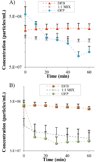Design of ultrasonically-activatable nanoparticles using low boiling point perfluorocarbons
- PMID: 22289265
- PMCID: PMC3291020
- DOI: 10.1016/j.biomaterials.2012.01.021
Design of ultrasonically-activatable nanoparticles using low boiling point perfluorocarbons
Abstract
Recently, an interest has developed in designing biomaterials for medical ultrasonics that can provide the acoustic activity of microbubbles, but with improved stability in vivo and a smaller size distribution for extravascular interrogation. One proposed alternative is the phase-change contrast agent. Phase-change contrast agents (PCCAs) consist of perfluorocarbons (PFCs) that are initially in liquid form, but can then be vaporized with acoustic energy. Crucial parameters for PCCAs include their sensitivity to acoustic energy, their size distribution, and their stability, and this manuscript provides insight into the custom design of PCCAs for balancing these parameters. Specifically, the relationship between size, thermal stability and sensitivity to ultrasound as a function of PFC boiling point and ambient temperature is illustrated. Emulsion stability and sensitivity can be 'tuned' by mixing PFCs in the gaseous state prior to condensation. Novel observations illustrate that stable droplets can be generated from PFCs with extremely low boiling points, such as octafluoropropane (b.p. -36.7 °C), which can be vaporized with acoustic parameters lower than previously observed. Results demonstrate the potential for low boiling point PFCs as a useful new class of compounds for activatable agents, which can be tailored to the desired application.
Copyright © 2012 Elsevier Ltd. All rights reserved.
Figures









Similar articles
-
Spontaneous Nucleation of Stable Perfluorocarbon Emulsions for Ultrasound Contrast Agents.Nano Lett. 2019 Jan 9;19(1):173-181. doi: 10.1021/acs.nanolett.8b03585. Epub 2018 Dec 19. Nano Lett. 2019. PMID: 30543289 Free PMC article.
-
Fluorous-phase iron oxide nanoparticles as enhancers of acoustic droplet vaporization of perfluorocarbons with supra-physiologic boiling point.J Control Release. 2019 May 28;302:54-62. doi: 10.1016/j.jconrel.2019.03.013. Epub 2019 Mar 27. J Control Release. 2019. PMID: 30928487
-
Phase-change nanoparticles using highly volatile perfluorocarbons: toward a platform for extravascular ultrasound imaging.Theranostics. 2012;2(12):1185-98. doi: 10.7150/thno.4846. Epub 2012 Dec 23. Theranostics. 2012. PMID: 23382775 Free PMC article. Review.
-
Image-Guided Ultrasound Characterization of Volatile Sub-Micron Phase-Shift Droplets in the 20-40 MHz Frequency Range.Ultrasound Med Biol. 2016 Mar;42(3):795-807. doi: 10.1016/j.ultrasmedbio.2015.11.012. Epub 2015 Dec 24. Ultrasound Med Biol. 2016. PMID: 26725168
-
Optimizing Acoustic Activation of Phase Change Contrast Agents With the Activation Pressure Matching Method: A Review.IEEE Trans Ultrason Ferroelectr Freq Control. 2017 Jan;64(1):264-272. doi: 10.1109/TUFFC.2016.2616304. Epub 2016 Oct 12. IEEE Trans Ultrason Ferroelectr Freq Control. 2017. PMID: 27740481 Free PMC article. Review.
Cited by
-
Sono-photoacoustic imaging of gold nanoemulsions: Part I. Exposure thresholds.Photoacoustics. 2015 Jan 2;3(1):3-10. doi: 10.1016/j.pacs.2014.12.001. eCollection 2015 Mar. Photoacoustics. 2015. PMID: 25893169 Free PMC article.
-
Acoustic droplet vaporization and propulsion of perfluorocarbon-loaded microbullets for targeted tissue penetration and deformation.Angew Chem Int Ed Engl. 2012 Jul 23;51(30):7519-22. doi: 10.1002/anie.201201902. Epub 2012 Jun 12. Angew Chem Int Ed Engl. 2012. PMID: 22692791 Free PMC article.
-
Factors Influencing the Repeated Transient Optical Droplet Vaporization Threshold and Lifetimes of Phase Change, Perfluorocarbon Nanodroplets.Nanomaterials (Basel). 2023 Aug 2;13(15):2238. doi: 10.3390/nano13152238. Nanomaterials (Basel). 2023. PMID: 37570555 Free PMC article.
-
Localized anesthesia of a specific brain region using ultrasound-responsive barbiturate nanodroplets.Theranostics. 2020 Feb 3;10(6):2849-2858. doi: 10.7150/thno.41566. eCollection 2020. Theranostics. 2020. PMID: 32194839 Free PMC article.
-
Vaporizable endoskeletal droplets via tunable interfacial melting transitions.Sci Adv. 2020 Apr 3;6(14):eaaz7188. doi: 10.1126/sciadv.aaz7188. eCollection 2020 Apr. Sci Adv. 2020. PMID: 32284985 Free PMC article.
References
-
- Kim T, Huh YM, Haam S, Lee K. Activatable nanomaterials at the forefront of biomedical sciences. J Mater Chem. 2010;20(38):8194–8206.
-
- Kripfgans OD, Fowlkes JB, Miller DL, Eldevik OP, Carson PL. Acoustic droplet vaporization for therapeutic and diagnostic applications. Ultrasound Med Biol. 2000;26(7):1177–1189. - PubMed
-
- Kripfgans OD, Fowlkes JB, Woydt M, Eldevik OP, Carson PL. In vivo droplet vaporization for occlusion therapy and phase aberration correction. IEEE Trans Ultrason Ferroelectr Freq Control. 2002;49(6):726–738. - PubMed
-
- Miller DL, Kripfgans OD, Fowlkes JB, Carson PL. Cavitation nucleation agents for nonthermal ultrasound therapy. J Acoust Soc Am. 2000;107(6):3480–3486. - PubMed
Publication types
MeSH terms
Substances
Grants and funding
LinkOut - more resources
Full Text Sources
Other Literature Sources
Miscellaneous

